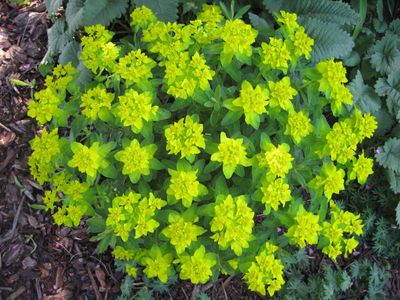Perennial favorites? These 10 are tops

I’m going out on a limb today by listing 10 of my favorite perennials for this region. All are cold-hardy, easy to grow, noninvasive, and add appealing colors or textures to the landscape.
•Cushion Spurge (Euphorbia polychroma) – This plant adds a “wow” factor to any bed and easily lights up dark corners of the garden. What appear to be yellow flowers are actually chartreuse-colored bracts. It prefers full sun but will grow in part shade and reaches an average height of 15 inches.
Spurges repel pocket gophers, an attribute that is very welcome in my rural garden. A related cultivar, “Bonfire,” has reddish-bronze leaves with chartreuse bracts.
•Purple Coneflower (Echinacea purpurea) – These attractive perennials withstand intense heat and strong winds. While most are familiar with purple or white cultivars, hybridizers have produced flowers in pale yellow and tropical orange shades.
The flowers attract butterflies and bees during the summer, and the seed heads provide an important food source for finches during fall and winter. Coneflowers prefer full sun, will reach a height of 3 feet and bloom all summer long.
•Mexican Hyssop, Sunset Hyssop (Agastache rupestris) – This plant thrives in the heat and is drought-tolerant, making it an ideal choice for xeriscaping. The nectar in its tubular flowers attracts butterflies and hummingbirds. The two-toned flowers are coral and lavender and the plants, which grow to 3 feet tall, are deer-resistant.
•Oriental Lily (Lilium orientalis) – If you are looking to make a statement in your perennial beds, nothing catches one’s attention like a stand of Oriental lilies. Their long list of desirable attributes includes exotic trumpet-shaped flowers in stunning colors, an intoxicating fragrance and cold-hardiness.
Flower colors include salmon, white, yellow, pink or two-toned. The bulbs are planted about 6 inches deep in the spring and grow to 3 feet in height in full sun or part shade.
•Hens and Chicks (Sempervivum tectorum) – How can a gardener not love a plant that tries so hard to please? These succulents have a rosette shape and are pale green to deep burgundy. They will grow in dry, severe conditions. Their name refers to the side shoots that develop off the mother plant, making them easy to propagate.
•English Lavender (Lavandula angustifolia) – Well-known for their soothing fragrance, these herbs have gray-green leaves and purple flowers that rise above the 1-foot-tall mounds. They are very drought-tolerant, love full sun and need no special care.
In June, the flowers attract butterflies, hummingbirds and bees. “Munstead” is the one of the best cultivars for this region.
•Feather Flower, Meadow Sweet, False Spirea (Astilbe x arendsii) – This plant makes an attractive addition to shady borders but also grows in full sun. Flower plumes bloom from June to July and come in white and shades of pink, including an appealing raspberry color. The deep-green foliage has a fernlike appearance.
•Plantain Lily (Hosta) – One of the most popular perennials, prized more for their foliage than their small flower stalks, Hostas thrive when grown in full to partial shade and moist, well-drained soil.
The leaves come in a variety of textures and colors from pale green to gold to blue. Cultivars come in all sizes and heights. The only downside is that deer think Hosta leaves are delicious.
•Stonecrop Autumn Joy (Sedum telephium) – This sun-loving favorite is a standout in the fall garden. At 2 feet tall, the plant features succulent, pale green leaves and rose-colored flower clusters that are a favorite of bees. Stonecrops are drought-tolerant and deer-resistant.
•Lenten Rose (Helleborus orientalis) – The most appealing attribute of this deer-resistant perennial is that it is one of the first plants to bloom in late winter or very early spring. They have palmate leaves and white, cream, pink, yellow or dark purple flowers.